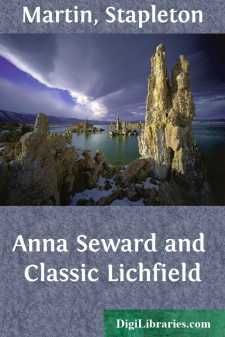Categories
- Antiques & Collectibles 13
- Architecture 36
- Art 48
- Bibles 22
- Biography & Autobiography 813
- Body, Mind & Spirit 142
- Business & Economics 28
- Children's Books 17
- Children's Fiction 14
- Computers 4
- Cooking 94
- Crafts & Hobbies 4
- Drama 346
- Education 46
- Family & Relationships 57
- Fiction 11829
- Games 19
- Gardening 17
- Health & Fitness 34
- History 1377
- House & Home 1
- Humor 147
- Juvenile Fiction 1873
- Juvenile Nonfiction 202
- Language Arts & Disciplines 88
- Law 16
- Literary Collections 686
- Literary Criticism 179
- Mathematics 13
- Medical 41
- Music 40
- Nature 179
- Non-Classifiable 1768
- Performing Arts 7
- Periodicals 1453
- Philosophy 64
- Photography 2
- Poetry 896
- Political Science 203
- Psychology 42
- Reference 154
- Religion 513
- Science 126
- Self-Help 84
- Social Science 81
- Sports & Recreation 34
- Study Aids 3
- Technology & Engineering 59
- Transportation 23
- Travel 463
- True Crime 29
Anna Seward and Classic Lichfield
by: Stapleton Martin
Categories:
Description:
Excerpt
ANNA SEWARD
Anna Seward, a daughter of the Rev. Thomas Seward, destined to become, by universal assent, the first poetess of her day in England, was born 12th December, 1747. Her mother was Elizabeth, one of the three daughters of the Rev. John Hunter (who was in 1704 appointed Head Master of Lichfield Grammar School), by his first wife, Miss Norton, a daughter of Edward Norton, of Warwick, and sister of the Rev. Thomas Norton, of Warwick. Anna Seward’s parents were married at Newton Regis Church, Warwickshire, in October, 1741. The poetess was born at Eyam in Derbyshire, where her father was then the Rector. She was baptized Anne, but she generally wrote her name Anna. Her pet name in her own family was “Nancy,” and also often “Julia.”
Mr. Seward attained some literary fame, and was co-adjutor to an edition of the works of Beaumont and Fletcher. When Anna Seward was seven years old, the family removed to Lichfield, and when she was thirteen they moved into the Bishop’s Palace, “our pleasant home” as she called it, where she continued to live after her father’s death, and for the remainder of her days.
The derivation of the word “Lichfield” has excited a good deal of controversy. In Anna Seward’s time, it was generally thought to mean “the field of dead bodies,” cadaverum campus—from a number of Christian bodies which lay massacred and unburied there, in the persecution raised by Diocletian. A reference to “Notes and Queries,” in the Sixth and Eighth Series, will show an inquirer that later search throws some doubt on such derivation. St. Chad, or Ceadda (669–672) founded the diocese of Lichfield, and was its patron saint.
The Cathedral, the Venus of Gothic creation, as now existing, was built piecemeal during the 13th and early part of 14th centuries. The present Bishop’s Palace is of stone, and was erected in 1687, by Thomas Wood, who was Bishop from 1671 to 1692, on the site of the old palace, built by Bishop Walter de Langton (1296–1321). The Bishops of Lichfield had a palace at Eccleshall, and this was the one used by these dignitaries down to the time of Bishop George Augustus Selwyn, who, it may be mentioned, was born 5th April, 1809. The latter sold it, and with part of the net proceeds added two ugly wings and an ugly chapel to the palace when he came to dwell there, in order to make it a centre of religious activity in the diocese. The body of the palace is, however, to this day little changed from its state when inhabited by the Sewards.
Anna Seward had several sisters, and one brother, all of whom died in infancy, except her second sister, Sarah. She, almost on the eve of marriage in her nineteenth year, to Mr. Porter, brother to Mrs. Lucy Porter of Lichfield, and son-in-law to Dr. Samuel Johnson, died in June, 1764. She is described as having been “lovely.”
A stanza in “The Visions,” an elegy, the first of the poems in Anna Seward’s “Poetical Works,” having reference to the sad event, runs thus:—
The bridal vestments waited to array,
In emblematic white, their duteous maid;
But ne’er for them arrived that festal day;
Their sweet, crush’d lily low in earth is laid.
John Hunter was Samuel Johnson’s schoolmaster, and Johnson declared that he was very “severe, and wrong-headedly severe.” He once said, “My master whipt me very well. Without that, sir, I should have done nothing.” Mrs. Hunter died in July, 1780, aged 66. She had been very beautiful, from all accounts, insomuch that Dr. Green, afterwards Bishop of Lincoln, and Dr. Newton, afterwards Bishop of Lichfield (“the learned and lucky pair”) were once, Anna Seward tells us, rivals in their attachment to her.
Miss Honora Sneyd was the youngest daughter of Edward Sneyd, who was the youngest son of Ralph Sneyd of Bishton, in Staffordshire. She was adopted by Mr. and Mrs. Seward and brought up by them as one of their own children....


